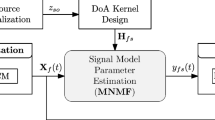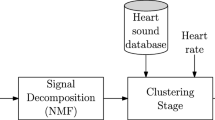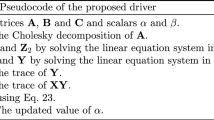Abstract
This paper presents a parallel low-latency multichannel source separation system designed to recover the original signals of the instruments that compound a multichannel music recording. Our approach is suitable for many applications based on interactive live broadcast classical music, where a latency of a few seconds can be assumed by online users. The obtained results show that it is possible to reach real time in the tested scenarios assuming a low-latency and combining multi-core architectures with parallel and high-performance techniques.





Similar content being viewed by others
References
Alonso P, Cortina R, Rodríguez-Serrano FJ, Vera-Candeas P, Alonso-González M, Ranilla J (2017) Parallel online time warping for real-time audio-to-score alignment in multi-core systems. The Journal of Supercomputing 73(1):126–138. https://doi.org/10.1007/s11227-016-1647-5
Alonso P, Vera-Candeas P, Cortina R, Ranilla J (2017) An efficient musical accompaniment parallel system for mobile devices. Journal of Supercomputing 73(1):343–353. https://doi.org/10.1007/s11227-016-1865-x
Anderson E, Bai Z, Bischof C, Blackford S, Demmel J, Dongarra J, Du Croz J, Greenbaum A, Hammarling S, McKenney A, Sorensen D (1999) LAPACK users’ guide, 3rd edn. Society for Industrial and Applied Mathematics, Philadelphia
Cabañas-Molero P, Cortina-Parajón R, Combarro EF, Alonso P, Bris-Peñalver FJ (2019) HReMAS: Hybrid real-time musical alignment system. The Journal of Supercomputing 75(3):1001–1013. https://doi.org/10.1007/s11227-018-2265-1
Campbell DR, Palomaki KJ, Brown GJ (2005) A MATLAB simulation of “shoebox” room acoustics for use in teaching and research. Computing and Information Systems Journal 9(3):48
Canadas-Quesada F, Vera-Candeas P, Martinez-Munoz D, Ruiz-Reyes N, Carabias-Orti J, Cabanas-Molero P (2016) Constrained non-negative matrix factorization for score-informed piano music restoration. Digital Signal Processing 50:240–257. https://doi.org/10.1016/j.dsp.2016.01.004
Carabias-Orti JJ, Cobos M, Vera-Candeas P, Rodríguez-Serrano FJ (2013) Nonnegative signal factorization with learnt instrument models for sound source separation in close-microphone recordings. EURASIP Journal on Advances in Signal Processing 2013(1):184. https://doi.org/10.1186/1687-6180-2013-184
Carabias-Orti, J. J., Rodriguez-Serrano, F., Vera-Candeas, P., Ruiz-Reyes, N., & Canadas-Quesada, F. J. (2015). An audio to score alignment framework using spectral factorization and dynamic time warping. In ISMIR: Proceedings of the International Conference of Music Information Retrieval (pp. 742–748)
Carabias-Orti JJ, Virtanen T, Vera-Candeas P, Ruiz-Reyes N, Canadas-Quesada FJ (2011) Musical instrument sound multi-excitation model for non-negative spectrogram factorization. IEEE Journal on Selected Topics in Signal Processing 5(6):1144–1158. https://doi.org/10.1109/JSTSP.2011.2159700
Chordia, P., & Rae, A. (2009). Using source separation to improve tempo detection. In: Proceedings of the 10th International Society for Music Information Retrieval Conference, ISMIR 2009 (pp. 183–188)
Dagum L, Menon R (1998) Openmp: An industry standard api for shared-memory programming. IEEE Computational Science and Engineering 5(1):46–55
Dessein, A., Cont, A., & Lemaitre, G. (2010). Real-time polyphonic music transcription with non-negative matrix factorization and beta-divergence. In Proceedings of the 11th International Society for Music Information Retrieval Conference, ISMIR 2010, (pp. 489–494)
Dessein, A., Cont, A., & Lemaitre, G. (2013). Real-time detection of overlapping sound events with non-negative matrix factorization. In Matrix information geometry, (pp. 341–371). Berlin: Springer. https://doi.org/10.1007/978-3-642-30232-9_14
Disch, S., Ertel, C., Faller, C., Herre, J., Hilpert, J., Hoelzer, A., Kroon, P., Linzmeier, K., & Spenger, C. (2004). Spatial audio coding: Next-generation efficient and compatible coding of multi-channel audio. In: Audio engineering society convention 117. Audio engineering society
Duan Z, Pardo B (2011) Soundprism: An online system for score-informed source separation of music audio. IEEE Journal of Selected Topics in Signal Processing 5(6):1205–1215. https://doi.org/10.1109/JSTSP.2011.2159701
Duong NQK, Vincent E, Gribonval R (2010) Under-determined reverberant audio source separation using a full-rank spatial covariance model. IEEE Transactions on Audio, Speech, and Language Processing 18(7):1830–1840. https://doi.org/10.1109/TASL.2010.2050716
Ewert, S., & Muller, M. (2011). Estimating note intensities in music recordings. In: 2011 IEEE International Conference on Acoustics, Speech and Signal Processing (ICASSP), (pp. 385–388). IEEE. https://doi.org/10.1109/ICASSP.2011.5946421
Frigo M (1999) A fast fourier transform compiler. ACM SIGPLAN Notices 10(1145/989393):989457
Goto, M. (2004). Development of the RWC music database. In Proceedings of the 18th International Congress on Acoustics (ICA 2004) (pp. 553–556)
Goto M, Hashiguchi H, Nishimura T, Oka R (2002) RWC music database: Popular, classical and Jazz music databases. Ismir 2:287–288
Hennequin, R., David, B., & Badeau, R. (2011). Score informed audio source separation using a parametric model of non-negative spectrogram. In 2011 IEEE International Conference on Acoustics, Speech and Signal Processing (ICASSP), (Vol. 1, pp. 45–48). IEEE. https://doi.org/10.1109/ICASSP.2011.5946324
Huang, P. S., Chen, S. D., Smaragdis, P., & Hasegawa-Johnson, M. (2012). Singing-voice separation from monaural recordings using robust principal component analysis. In IEEE International Conference on Acoustics, Speech and Signal Processing (ICASSP) (pp. 57–60).
Itoyama K, Goto M, Komatani K, Ogata T, Okuno HG (2008) Instrument equalizer for query-by-example retrieval: Improving sound source separation based on integrated harmonic and inharmonic models. Ismir. https://doi.org/10.1136/bmj.324.7341.827
Li B, Liu X, Dinesh K, Duan Z, Sharma G (2019) Creating a multitrack classical music performance dataset for multimodal music analysis: challenges, insights, and applications. IEEE Transactions on Multimedia 21(2):522–535. https://doi.org/10.1109/TMM.2018.2856090
Marxer, R. (2013). Audio source separation for music in low-latency and high-latency scenarios.
Miron, M., Carabias, J. J., & Janer, J. (2015). Improving score-informed source separation for classical music through note refinement. In: Proceedings of the International Society for Music Information Retrieval (ISMIR) Conference (pp. 448–454).
Miron M, Carabias-Orti JJ, Bosch JJ, Gómez E, Janer J (2016) Score-informed source separation for multichannel orchestral recordings. Journal of Electrical and Computer Engineering 2016:1–19. https://doi.org/10.1155/2016/8363507
Munoz-Montoro AJ, Carabias-Orti JJ, Vera-Candeas P, Canadas-Quesada FJ, Ruiz-Reyes N (2019) Online/offline score informed music signal decomposition: Application to minus one. EURASIP Journal on Audio, Speech, and Music Processing 2019(1):23. https://doi.org/10.1186/s13636-019-0168-6
Muñoz-Montoro AJ, Ranilla J, Vera-Candeas P, Combarro EF, Alonso-Jordá P (2018) Real-time soundprism. The Journal of Supercomputing. https://doi.org/10.1007/s11227-018-2703-0
Pätynen J, Pulkki V, Lokki T (2008) Anechoic recording system for symphony orchestra. Acta Acustica United with Acustica 94(6):856–865. https://doi.org/10.3813/AAA.918104
Rodríguez-Serrano FJ, Carabias-Orti JJ, Vera-Candeas P, Canadas-Quesada FJ, Ruiz-Reyes N (2014) Monophonic constrained non-negative sparse coding using instrument models for audio separation and transcription of monophonic source-based polyphonic mixtures. Multimedia Tools and Applications 72(1):925–949. https://doi.org/10.1007/s11042-013-1398-8
Rodriguez-Serrano FJ, Duan Z, Vera-Candeas P, Pardo B, Carabias-Orti JJ (2015) Online score-informed source separation with adaptive instrument models. Journal of New Music Research 44(2):83–96. https://doi.org/10.1080/09298215.2014.989174
Turetsky, R., & Ellis, D. (2003). Ground-truth transcriptions of real music from force-aligned MIDI syntheses. In: Proceedings of the 4th International Symposium on Music Information Retrieval (pp. 135–141). https://doi.org/10.7916/D8S472CZ.
Vincent E, Araki S, Theis F, Nolte G, Bofill P, Sawada H, Ozerov A, Gowreesunker V, Lutter D, Duong NQ (2012) The signal separation evaluation campaign (2007–2010): Achievements and remaining challenges. Signal Processing 92(8):1928–1936. https://doi.org/10.1016/j.sigpro.2011.10.007
Vincent E, Gribonval R, Fevotte C (2006) Performance measurement in blind audio source separation. IEEE Transactions on Audio, Speech and Language Processing 14(4):1462–1469. https://doi.org/10.1109/TSA.2005.858005
Vincent, E., & Plumbley, M. (2005). A prototype system for object coding of musical audio. In IEEE Workshop on Applications of Signal Processing to Audio and Acoustics (pp. 239–242). IEEE. https://doi.org/10.1109/ASPAA.2005.1540214.
Viste, H., & Evangelista, G. (2001). Sound source separation: Preprocessing for hearing aids and structured audio coding. In: COST G-6 Conference on Digital Audio Effects (DAFX-01), (pp. 67–70).
Woodruff, J., Pardo, B., & Dannenberg, R. (2006). Remixing stereo music with score-informed source separation. In Proceedings of the 7th International Society for Music Information Retrieval Conference (ISMIR).
Acknowledgements
This work has been supported by the Regional Ministry of the Principado de Asturias under Grants FC-GRUPIN-IDI/2018/000226, the Government of the Junta de Andalucía under Grants “PAIDI 2020. Convocatoria 2017 de Ayudas a Actividades de Transferencia de Conocimiento” with reference AT-6044, and the University of Jaén under the program “Acción 1. Apoyo a las estructuras de investigación de la Universidad de Jaén para incrementar su competitividad atendiendo a sus singularidades”.
Author information
Authors and Affiliations
Corresponding author
Additional information
Publisher's Note
Springer Nature remains neutral with regard to jurisdictional claims in published maps and institutional affiliations.
Rights and permissions
About this article
Cite this article
Muñoz-Montoro, A.J., Suarez-Dou, D., Carabias-Orti, J.J. et al. Parallel multichannel music source separation system. J Supercomput 77, 619–637 (2021). https://doi.org/10.1007/s11227-020-03282-2
Published:
Issue Date:
DOI: https://doi.org/10.1007/s11227-020-03282-2




